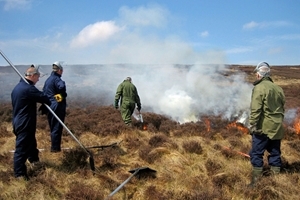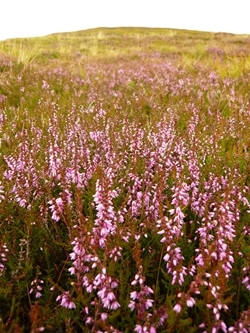Key points
- Burning vegetation on UK moorlands is part of routine management for red grouse, but its contribution to peatland degradation is widely debated.
- In a moor managed for grouse, areas that had been burned between the winters of 2008/09 and 2014/15 were revisited in 2019 to look at how the vegetation responded compared to areas that were not burnt.
- Sphagnum cover in plots burnt eight to ten years earlier was, on average, five times higher than areas that were not burnt.
- Prescribed burning at regular intervals can increase Sphagnum cover by reducing heather cover and other vegetation.
- Prescribed burning can also reduce the risk of wildfire by removing the amount of fuel available and providing fire breaks.
Background
 Peatland habitats in the United Kingdom are of global importance, maintaining key ecosystems including carbon storage. They are also important for water quality and reducing the risk of flooding. The peatland vegetation community is typically dominated by ling heather, cotton grasses and Sphagnum mosses. Sphagnum moss is often associated with peat formation, thriving in wet conditions.
Peatland habitats in the United Kingdom are of global importance, maintaining key ecosystems including carbon storage. They are also important for water quality and reducing the risk of flooding. The peatland vegetation community is typically dominated by ling heather, cotton grasses and Sphagnum mosses. Sphagnum moss is often associated with peat formation, thriving in wet conditions.
Moorland is traditionally managed by a combination of burning and livestock grazing, the former especially used on sites with red grouse shooting. After burning, the new heather shoots have a higher nutritional content, which can support higher numbers of red grouse. The different vegetation heights and structures created can benefit some ground-nesting birds including golden plover.
However, burning is still a controversial issue. Some claim it contributes to peatland degradation, reduces carbon storage, releases toxic metals into the atmosphere, damages plant species including Sphagnum, and reduces floral diversity by increasing heather cover. If these prescribed burns become unmanageable, they can pose a great risk to the habitat and could lead to wildfires.
Studies have shown regular burning, about every 10 years, can benefit Sphagnum and cotton grass when compared to longer burn intervals. Furthermore, it has been demonstrated that areas that have been burnt can still store carbon and can reduce the risk of wildfire. This study aims to further explore how peatland vegetation responds to burning.
What they did
This study took place on Langholm Moor in southwest Scotland, which supports a mix of different vegetation and has a history of moorland management including grazing and burning. Between 2008 and 2016, there were approximately 1,000 fires conducted and mapped on Langholm Moor Demonstration Project
There was a total of six burn-years between the winters of 2008-2009 to 2014-2015. From these, eight burns were randomly selected from each winter to look at the effect on vegetation composition and structure of time since the area was last burnt (‘burn-age’). This gave a total of 48 burns with a burn-age between four and ten years. There were also 16 plots where no burning had taken place since 2008, known as no-burn control plots.
Within each area, the scientists measured the percentage cover of heather, cotton grass, Sphagnum, and other mosses. They also recorded vegetation height, moss depth and vegetation biomass, with all of these measurements then being considered in relation to burn-age.
What they found
 Heather cover was significantly lower in the first seven years after burning when compared to no-burn plots. Cotton grass also showed significant differences between burn-ages and the controls, with cover being significantly higher in all burn plots than in the unburned controls.
Heather cover was significantly lower in the first seven years after burning when compared to no-burn plots. Cotton grass also showed significant differences between burn-ages and the controls, with cover being significantly higher in all burn plots than in the unburned controls.
The amount of Sphagnum cover was also affected by burn-age. Between years 8–10, cover was highly variable and there was a small drop-off in years 4–6. Yet, cover was still five times higher than on no-burn control plots. Regardless of burn-age, Sphagnum cover was greater where peat was deeper.
Burn-age did not appear to affect moss depth, although it could be suggested that fire may reduce moss depth in the early years after burning. In four-year-old burns, moss depth was approximately half the depth of that in older burns and in the controls. There was no overall effect of burn-age on diversity of either vascular plants or mosses.
What does this mean?
There were increases in heather and non-Sphagnum moss cover during the ten years after burning. Although the moss depth was at its lowest in four-year old burns, it appeared to have been restored within six years. Heather cover, vegetation height and biomass all showed similar increases over time post-burn. This highlights the role managed burns have in reducing the amount of canopy vegetation, which will help peat-forming species like Sphagnum by reducing competition for light.
Sphagnum cover in plots that were burnt eight to ten years earlier was on average five times higher than the cover in the no-burn control plots. Although the high temperatures during burns can damage Sphagnum, it can recover from low intensity (cool) burns within the same growing season. Therefore, cool burns can reduce heather cover without destroying the Sphagnum layer beneath.
Regarding wildfires, prescribed management fires can reduce the amount fuel available, therefore reducing both the intensity and severity of any fire that does occur. Removing the excess vegetation can provide fire breaks, disrupting fire fronts. Gamekeepers on grouse moors have considerable experience and adequate equipment to tackle wildfires, but this could all be lost if they are no longer able to conduct prescribed burns.
Overall, these results are further evidence to suggest prescribed burning at appropriate time intervals can help peat-forming vegetation by reducing competition from heather. It is recommended there should be long-term experiments that have properly designed control and burn treatments to better understand the impact on vegetation.
Read the original paper
Whitehead, S., Weald, H., Baines, D., Post-burning responses by vegetation on blanket bog peatland sites on a Scottish grouse moor. Ecological Indicators, Volume 123, 2021, ISSN 1470-160X.